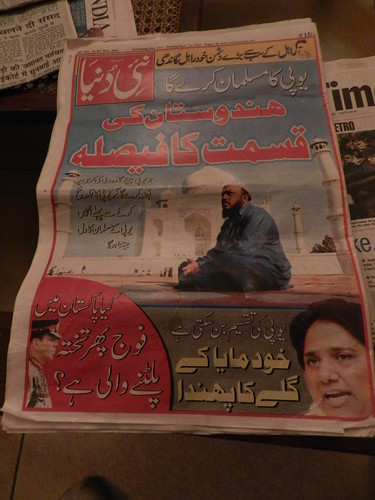By Mohammad Sajjad,
As a school student in the 1980s in rural north Bihar, I have grown up reading few news periodicals, some of these occasionally, others almost regularly; these include, the English weekly Sunday, Urdu weekly Nai Duniya, Urdu daily Akhbar-e-Mashriq, Calcutta, which reached my remote village by post almost after a week, English daily the Searchlight, Patna (closed down in 1986), and a Hindi periodical from Allahabad, Maya (now dead), besides sparingly purchased issues of the Blitz (Urdu), Bombay.
Even though too early for me to comprehend many things in the early 1980s, yet, I could somehow make out, vaguely, that the overall tilt of the Nai Duniya, as compared to all other news periodicals studied by me, was something I was not much comfortable with; it had communal overtones, pushing the community in retrogressive direction. The Nai Duniya used to carry the cover stories in red coloured and big-sized fonts in a rather specifically provocative manner. One such story I can still recall was, “…aur puri duniya pe Islami hukumat qaayem ho jaayegi”. (It was on Nostradamus’ predictions). It will carry its sports column on cricket implicitly injecting pro-Pakistan sentiments; will publish coloured photographs of Pakistani cricket icons. Its sale will get boosted once a communal riot broke out, and the decade of the 1980s had horribly more of it.

The Matiya Burj (Calcutta) riots, which had killed the Dy. Comsr. Of Police, Mehta, and his bodyguard, Mukhtar, had made the news even more sensitive. The coverage of such riots in the Akhbar-e-Mashriq
and in the Nai Duniya will be done with different approaches; the later will be more sensational. My father will enquire it from his IPS friends like Mr. Taiyab Khan, and Mr. Mohd. Nizam about such issues and share with us, only to help us understand the ‘mischievous’ ways of the Nai Duniya, with greater clarity.
After the demolition of Babri Masjid in 1992, what one could unmistakably feel that the Nai Duniya no longer remained as much popular among the Muslims of Bihar and U.P. (After coming to Aligarh I came to feel that compared to Bihar Muslims, greater proportion of the UP Muslims were less familiar with Urdu script; they wrote letters to their parents in Nagri). In the early months of 1993 there were ‘Muslim Intelligentsia Meets’, and views started coming out from within the community; they were critical of their pre-existing leadership pursuing politics more around the emotive issues of identity. Much before the demolition, the Frontline, in 1991, would publish about violent preparations of the Hindutva brigade, “Polishing the Claws”, etc. The more radical CPI-ML, and its student wing, AISA, besides bringing the data of poverty, backwardness, and underrepresentation of Muslims in the structures and processes of power, will publish pamphlets persuading “confrontationist secularism”, whereby the violent Hindutva brigade had to be taken on physically, and that the law enforcers were mostly on the side of them; their words proved prophetic on 6 December 1992. Whereas, other progressive sections of the mainstream English language print-media were engaged in combating the Hindutva canards about appeasement of Muslims by the ruling Congress. These sections of the print-media will reproduce statistics showing acute poverty among the Muslims and their painful underrepresentation in education and employment. The Communist Parties will bring out booklets like, “Hindu Communalism X-rayed”, “The Myth of Muslim Appeasement Exposed”, much before the demolition, the Frontline, in 1991, will publish, violent preparations of the Hindutva brigade, “Polishing the Claws”, etc.
No such statistics/report was to be found in the Nai Duniya’s editions of the 1980s. Not even translations of such contents published in these pamphlets/booklets. Understandably, the beleaguered Muslim community of Post-demolition India had come of age, and had grown up enough to see through the game-plans of the newspapers like the Nai Duniya. Ever since then I did not hear much of the Nai Duniya, except the fact that its editor, Shahid Siddiqi was doing deft political foot-working and had succeeded in carving an image of crassest opportunist, every now and then shifting his political affiliations. I could recall what a rustic, illiterate, landless labourer of my village had angrily told his own representative (in the Lok Sabha) during an election campaign, “The whores might take longer to change their clothes than you politicians take to change your party affiliations”.
The 30 July 2012 edition of the Nai Duniya, and what I am reading about it in the Tehelka 11 August 2012, has made it clear to me that what I felt about the Nai Duniya during my childhood, stands vindicated and endorsed today. Moreover given the fact that Zafar Sareshwala, an Ahmedabad-based businessman close to Narendra Modi, has been an interlocutor in arranging the five page interview of Modi in the Nai Duniya, makes it pretty clear that the editor Shahid Siddiqui has really discovered a “Nai Duniya” (i.e., new world) for his own future prospects. Is it another version of the Vajpayee Himayat Committee of 2004? Only Shahid Siddiqui can tell us!
—
Mohammad Sajjad is Asstt. Prof. at Centre of Advanced Study in History, Aligarh Muslim University.

